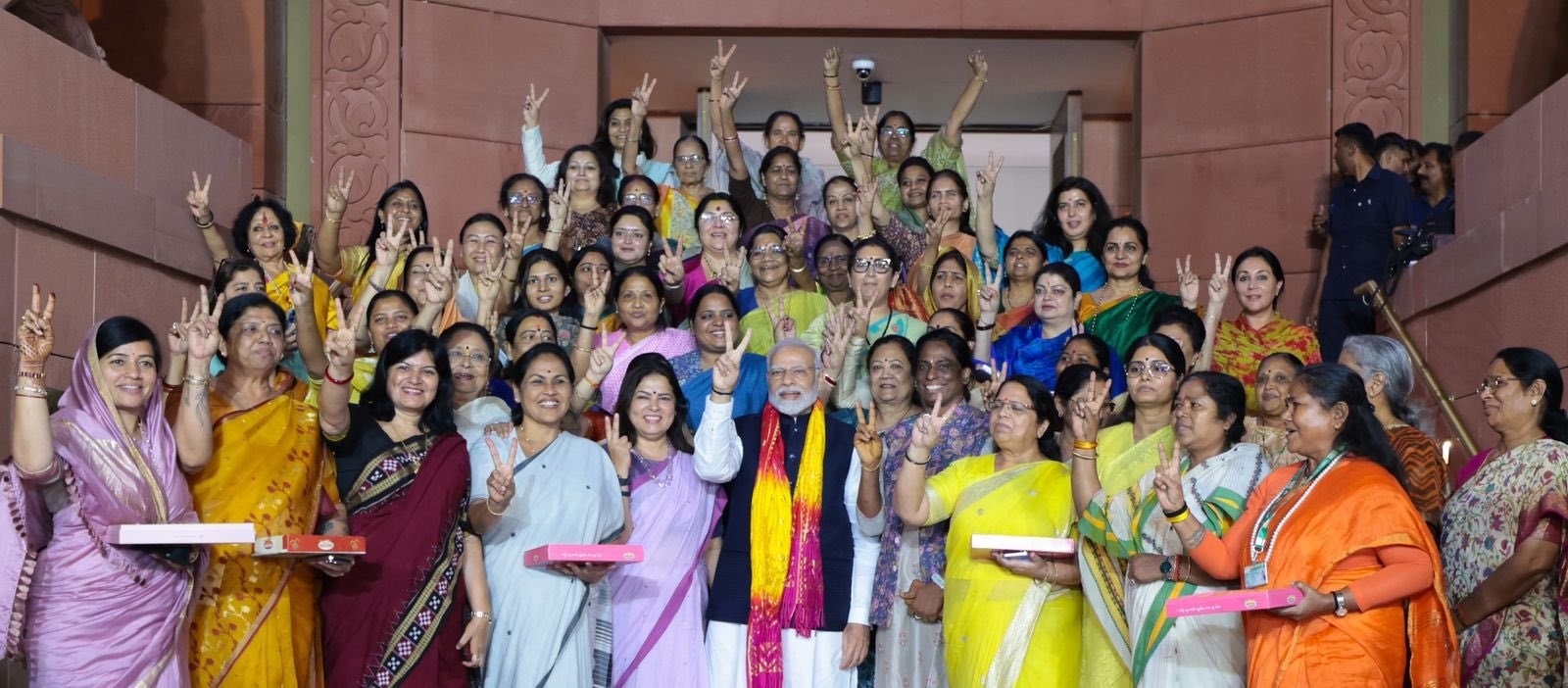Women MPsTORCH-BEARERS OFTRANSFORMATION
| Date :05-Nov-2023 |

By Vijay Phanshikar :
“Had the honour of meeting our dynamic women MPs who are absolutely thrilled at the passage of the Nari Shakti Vandan Abhiyan. It is gladdening to see the torch-bearers of change come together to celebrate the very legislation they have championed. With the passage of the Nari Shakti Vandan Abhiyan, India stands at the cusp of a brighter, more inclusive future with our Nari Shakti being at the core of this transformation.” - PM Narendra Modi on X (formerly Twitter)

PRIME Minister Mr
Narendra Modi could
not conceal his sense of
deep satisfaction and
clear joy upon meeting
the jubilant women Members of
Parliament following the passage
of legislation ensuring reservation for women in parliament
and other elective forums in the
country. He had all the time been
one of the strongest votaries of
such a legislation and worked
hard to ensure that the entire
membership of Parliament
across the wide spectrum of ideologies came together to pass the
Women’s Quota Bill so poetically
named Nari Shakti Vandan
Abhiyan.
The passage of the Bill really
marked a historic moment for
the country’s parliamentary history. As he pressed for its passage, Mr. Narendra Modi had
hailed the contribution women
made in India’s parliamentary
experience, stating, in effect, that
since the first Lok Sabha, about
7,500 Members of Parliament
had contributed in the parliamentary democracy, of which
600 were women.
But as Parliament zeroed in on
the passage of the Nari Shakti
Vandan Abhiyan, those who
thought deeply about the subject
realised that the country’s polity
had travelled a good distance --
to have now as many as 78
women Members of Parliament
in the Lok Sabha, the highest
number so far. And among those
numbers, as many as 40 belong
to the ruling Bharatiya Janata
Party (BJP).
To make a proper statement of
assertion of his faith and trust in
women’s ability to enrich parliamentary experience, Prime
Minister Mr. Narendra Modi had
included as many as eleven
women in his Council of
Ministers, again the highest
number so far.
As the country is just about six
months away from the next Lok
Sabha elections, it may be a good
time to take a look at how
women Members of Parliament
(MPs) have fared in the last fourand-a-half years of parliamentary exposure.
With women
members forming nearly 15 per
cent of membership of the Lok
Sabha, it was only natural for the
country to notice what the
women did on the floor of the
Lok Sabha -- besides bringing
certain glamour to the place. Of
course, Parliament is a place of
serious business of law-making
for the larger interest of the
country, every member works
hard to extract the best benefit of
his or her presence in the House
-- asking questions, seeking
explanations, raising issues, taking sides, launching blistering
attack on the people on the other
side of the political or ideological
divide.
In the 17th Lok Sabha that
began its sittings after the elections in 2019, women MPs were
watched with much
interest. For, whatever they would do
would represent the
level of women’s
empowerment in the
parliamentary system and democratic
polity. Research over
a long time had often
suggested that there
was a clear disparity
between the performance of men
and women Members of
Parliament not just in India but
also across the world. In numbers also, the Indian women
fared less brightly as did their
counterparts in other parts of the
world. If India’s Lok Sabha has
presently 15 per cent women
among its membership, in the
United States the number is
about 28 per cent and England
about 34 per cent. By that standard, India has to go a long way
to equal up sensibly with the
world averages.
Yet, the picture
has become brighter
in the past few
years, one must
insist.
A closer look at
the performance of
women MPs in the
Lok Sabha, one
realises that a lot
depended upon
what scope different political
parties gave women among their
respective memberships.
On this
count, the ruling Bharatiya
Janata Party appears to have
established a clear lead over all
other parties. This was visible in
the attendance in the House, the
numbers of questions asked by
women MPs, and their participation in debates and pushing
Private Member Bills, for example. On most counts, as the statistics reveal, the BJP’s women
MPs fared much better than their
counterparts in other parties.
In the 15th Lok Sabha, there
were 64 women Members of
Parliament, with the BJP having
14 women members (about 12
per cent of the total of BJP members). The Congress party had 25
women MPs (again about 12 per
cent of the party’s total membership in the House). In the 16th
Lok Sabha, the numbers tilted
more in the BJP’s favour --
among the total of 68 women
MPs, with the BJP having 32
women on its benches (about 11
per cent) and the Congress party
had only four women members
(about 8 per cent of its total
numbers). Data reveals that
women members asked markedly fewer questions -- 135 -- than
men MPs -- 250. In the 16th Lok
Sabha, things changed for the
better and women members’
performance was on par (218)
with that of men MPs (219)
points of active engagement in
the proceedings.
Data also reveals that the
median number of questions
raised by women members from
the Bharatiya Janata Party (which
was the leading Opposition party
in the 15th Lok Sabha) was 355,
while the median number of
questions asked by the leading
ruling party Congress in the 15th
Lok Sabha was only 58. This indicates clearly the kind of active
functioning the BJP parliamentary party had within its folds.
That impression has substance. For, even when the BJP
became a leading party in the
ruling combine, its members,
and especially women members,
kept raising issues that even cornered their own party’s
Government, so to say. For example, women MPs from BJP in the
16th Lok Sabha raised a substantial number of questions -- 346 --
to their own Government. This
trend continued even in the current -- 17th -- Lok Sabha with
women MPs from the BJP asking
critical questions of ministries in
their own Government, often
encouraged by Prime Minister
Mr. Narendra Mod (as part of the
BJP’s parliamentary culture).
Their focus is mainly on healthcare, public welfare schemes
such as Jan Dhan Yojana, education, small and medium enterprises, defence, external affairs,
agriculture ...!
The overall experience of
women in Parliament has been
encouraging on most counts,
with the BJP leading on all the
fronts. With the next Lok Sabha
elections now just a few months
away, the issue of the quantity
and quality of performance of all
MPs will come in stark stare. And
in that scrutiny, women MPs will
haveareason to feel great about
themselves.